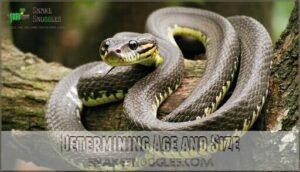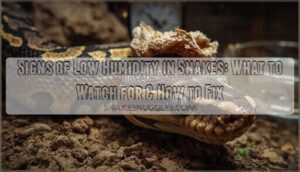This site is supported by our readers. We may earn a commission, at no cost to you, if you purchase through links.

Use feeding tongs to maintain distance and offer pre-killed frozen prey that’s 10-15% of your snake’s body weight. Feed juveniles weekly, adults every 2-3 weeks.
Create a feeding routine in a separate container to avoid cage aggression. Your snake’s striking instinct doesn’t distinguish between food and fingers, so never hand-feed.
Watch for the telltale S-curve posture that signals feeding mode. Temperature matters too – prey should be warmed to body temperature for ideal digestion.
The real game-changer lies in understanding your specific species’ unique feeding behaviors, and maintaining a safe environment is crucial for successful feeding, which involves a careful balance and prey response, and considering the snake’s body weight.
Table Of Contents
- Key Takeaways
- How to Feed a Snake Safely?
- Understanding The Snake’s Diet
- Frequency of Feeding
- Feeding Methods
- Determining Age and Size
- Prey Size Guidelines
- Choosing The Right Prey
- Feeding Frequency by Species
- Nutritional Needs
- Vitamin and Mineral Supplements
- Safe Handling Practices
- Frequently Asked Questions (FAQs)
- How do you feed a snake?
- Can you feed a pet snake?
- Do snakes need a lot of food?
- Do snakes need a feeding tub?
- Should pet snakes eat live or frozen prey?
- Can snakes eat live prey?
- What not to do when feeding a snake?
- Are you supposed to feed a snake in its cage?
- How long can a snake go without eating?
- How to present food to a snake?
- Conclusion
Key Takeaways
- Use feeding tongs and pre-killed prey – You’ll avoid injury risks by maintaining a safe distance with feeding tongs and offering frozen-thawed prey that’s 10-15% of your snake’s body weight, eliminating the danger of live rodents fighting back.
- Follow species-specific feeding schedules – You should feed juveniles weekly and adults every 2-3 weeks, adjusting frequency based on your snake’s age and species rather than your convenience to prevent overfeeding or nutritional deficiencies.
- Choose proper prey size – You need to select prey that’s 1-1.5 times your snake’s head diameter to ensure safe digestion and prevent choking hazards or regurgitation issues.
- Create consistent feeding routines – You’ll reduce stress and cage aggression by establishing regular feeding times in your snake’s enclosure, warming prey to body temperature, and never handling your snake immediately after meals.
How to Feed a Snake Safely?
Feeding your snake safely requires understanding basic snake nutrition principles and proper techniques. Snakes are obligate carnivores, meaning they’ll only thrive on whole prey animals like mice or rats.
Choose prey that’s 1-1.5 times your snake’s head diameter for ideal digestion care. Use feeding tongs to maintain safe distance during prey handling – this prevents accidental bites and keeps your fingers intact.
Feed hatchlings every 5-7 days and adults every 7-10 days, following a consistent snake feeding schedule. Always wash your hands before and after handling sessions.
Monitor your snake’s body condition regularly to avoid overfeeding. These snake feeding tips form the foundation of responsible reptile ownership, ensuring your pet stays healthy while keeping you safe during feeding time.
Understanding The Snake’s Diet
Over 3,000 snake species exist worldwide, each with distinct dietary needs that you’ll need to understand for proper care. Your snake is an obligate carnivore, meaning it derives all nutrients exclusively from animal-based food sources.
Understanding your snake’s species-specific diet isn’t optional—it’s the foundation of responsible reptile ownership and your pet’s long-term health.
This carnivore diet requires high protein requirements that plant matter simply can’t provide. Snake nutrition facts reveal that different species have specialized prey preferences.
While most pet snakes thrive on rodent-based diets, some require birds, fish, or even other reptiles. King cobras eat other snakes, while garter snakes maintain more varied menus.
Understanding your specific snake’s natural food sources is vital for feeding snakes safely. Your snake’s dietary needs directly impact its health, growth, and longevity.
Research your species’ requirements thoroughly, as nutritional deficiencies can lead to serious health problems. Proper snake feeding techniques start with knowing exactly what your pet should eat in the wild.
To maintain a balanced diet, it’s necessary to understand whole prey benefits for your snake’s overall health and well-being.
Frequency of Feeding
Getting your snake’s diet basics down is just the first step—now you need to master the timing. Feeding schedules aren’t one-size-fits-all, and getting meal frequency right directly impacts your pet’s health and happiness.
Timing isn’t just important—it’s everything when it comes to keeping your snake healthy and thriving.
Snake growth patterns determine how often you’ll be opening that freezer. Hatchlings burn through calories fast, requiring meals every 5-7 days to fuel their rapid development. Adult snakes have slower digestion rates and can comfortably wait 7-10 days between feedings. Your feeding intervals should match your snake’s metabolism, not your convenience.
Here’s what affects feeding frequency by species:
- Ball pythons need consistent weekly schedules during growth phases
- Corn snakes can handle slightly longer intervals as adults
- Larger species like boas require bigger meals less frequently
- Seasonal changes may alter appetite patterns naturally
- Individual snake’s body condition should guide adjustments
Monitor your snake’s weight regularly—a bulging belly signals overfeeding risks that can compromise long-term health.
Feeding Methods
Now that you’ve established your feeding schedule, let’s explore the snake feeding methods that’ll keep both you and your serpent safe.
You have two primary feeding techniques: live feeding and prekilled feeding. Live feeding mimics natural hunting behavior but carries injury risks from defensive prey. Prekilled feeding eliminates these dangers while remaining nutritionally complete.
Prey presentation matters substantially. Always use feeding tongs to maintain safe distance during handling prey. Food temperature should reach body heat – around 98°F – to trigger your snake’s feeding response. Cold prey often gets rejected.
| Method | Advantages | Disadvantages |
|---|---|---|
| Live Feeding | Natural hunting behavior | Injury risk to snake |
| Prekilled Feeding | Safer, convenient storage | May require feeding stimulation |
Professional snake feeding equipment includes long tongs, separate feeding containers, and thermometers. These tools transform feeding from stressful guesswork into controlled, predictable routines that benefit everyone involved. Proper feeding management techniques require understanding safe feeding practices to guarantee the health and well-being of your pet snake.
Determining Age and Size
Understanding your snake’s age and size determination forms the foundation for proper feeding schedules. Like matching shoes to foot size, you can’t feed appropriately without knowing these basics. Age Factors and Development Stages work hand-in-hand since snakes grow predictably throughout their lives.
Size Measurement involves checking your snake’s length and examining body circumference at the thickest point. Weight Tracking provides another reliable indicator – hatchlings typically weigh just a few grams while adults can reach several pounds depending on species. Growth Charts help you compare your snake’s measurements against standard development patterns.
Here’s what makes this process rewarding:
- You’ll develop a deeper bond by understanding your pet’s life stage
- Watching your snake grow from hatchling to adult becomes incredibly satisfying
Most snake age estimates rely on physical measurements rather than exact dates. Young snakes under six months show rapid growth, while adults maintain stable sizes. This information directly impacts your feeding frequency by species decisions.
Prey Size Guidelines
Finding the right prey size is like choosing clothes that fit—too small and you’re left hungry, too big and you’re in trouble. Prey Measurement forms the backbone of safe Snake Sizing practices, preventing choking hazards and digestive complications.
Feeding Charts serve as your roadmap, but here’s what really matters for Rodent Sizes and Digestion Safety. Remember, prey size guidelines aren’t suggestions—they’re snake feeding essentials.
- Hatchlings (0-6 months): Offer prey 1-1.5 times your snake’s head diameter—think pinkie mice for most species.
- Juveniles (6-12 months): Scale up to 1.5-2 times head width—fuzzy mice work perfectly here.
- Sub-adults (1-2 years): Target 2-2.5 times head diameter—hopper mice fit the bill.
- Adults: Go for 2.5-3 times head width—adult mice or rat pups depending on species.
Your snake’s widest body point shouldn’t bulge noticeably after eating. Prey selection mistakes can mean expensive vet bills.
Choosing The Right Prey
You’ll need to select appropriate prey that matches your snake’s species, size, and feeding preferences to guarantee proper nutrition and safety.
The right prey choice depends on factors like your snake’s natural diet, whether you prefer live or frozen-thawed options, and your comfort level with different feeding methods, including considerations for proper nutrition.
Convenient Feeding Methods
Several convenient feeding techniques streamline your snake’s mealtime while prioritizing safety.
Use feeding tongs to present prey, maintaining safe distance from striking zones. Snake hooks help position your pet securely.
For prey storage, frozen options offer flexibility—just make certain proper food warming to body temperature before serving.
These snake feeding methods reduce stress for both you and your serpent companion.
Effective snake care involves using proper snake feeding tools to handle and feed your pet.
Maintaining Cage Cleanliness
Cage cleanliness directly impacts your snake’s health and feeding success. Regular waste removal and proper hygiene practices prevent bacterial growth that could harm your pet.
Establish cleaning schedules for enclosure maintenance, removing uneaten prey within hours to avoid contamination. Clean feeding tools between uses, and spot-clean soiled substrate immediately.
A sanitized environment reduces disease risk and creates ideal conditions for safe snake handling during feeding sessions. Effective snake care also involves using proper snake cleaning tools(snake cleaning) to maintain a healthy environment.
Avoiding Overfeeding Risks
You risk your snake’s health when you ignore proper feeding schedules and prey size guidelines.
Snake obesity creates serious health risks, including organ failure and shortened lifespan. Weight monitoring helps prevent these dangerous feeding mistakes.
Accurate snake food measurements require understanding a snake food scale.
Key overfeeding prevention strategies:
- Follow species-specific feeding frequency recommendations
- Match prey size to your snake’s head diameter
- Track your pet’s body condition regularly
- Adjust diet planning based on activity levels
Feeding Frequency by Species
Species Feeding schedules vary dramatically across the snake world. Ball pythons thrive on feeding intervals of every 10-14 days, while corn snakes maintain healthy weights with meals every 7-10 days.
Your snake’s age plays a vital role in determining proper feeding frequency by species – juveniles need snake feeding frequency of every 5-7 days, but adults can wait 7-14 days between meals.
Larger constrictors like Burmese pythons may only require monthly feeding sessions. Understanding these snake schedules helps you’re meeting your pet’s specific dietary needs without overfeeding or underfeeding based on their natural metabolism and growth requirements.
Nutritional Needs
Understanding your snake’s nutritional needs is like building the foundation of a house – get it wrong, and everything else crumbles.
Snake nutrition revolves around complete, balanced nutrient intake from whole prey animals that provide essential protein sources, vitamins, and minerals in perfect harmony.
Your snake’s dietary balance depends on three critical components:
- Protein requirements – Must comprise 80-90% of total caloric intake for muscle maintenance and growth
- Calcium-to-phosphorus ratio – Should maintain a precise 2:1 balance for strong bones and proper shedding
- Essential fatty acids – Support organ function, immune system, and reproductive health.
Food quality matters tremendously. Whole prey animals deliver complete nutritional profiles that isolated supplements can’t match.
When feeding snakes live or frozen-thawed prey, you’re providing nature’s perfect nutritional package. Snake nutritional needs vary by species, age, and breeding status, but the core principle remains: prioritize whole prey over partial meals.
This approach guarantees your snake receives the best nutrition without guesswork or deficiencies.
Vitamin and Mineral Supplements
Most pet snakes don’t need regular vitamin supplements when you’re feeding whole prey items.
However, certain situations call for extra nutritional support to meet their specific needs.
- Calcium Needs – Growing snakes require calcium powder with a 2:1 calcium-to-phosphorus ratio for strong bone development
- Vitamin D – Indoor snakes need vitamin D3 supplementation since they lack natural sunlight exposure
- Mineral Balance – Trace minerals like zinc and iron support proper immune system function
- Supplement Types – Dusting powder, liquid preparations, or complete gel diets provide different administration options
- Nutrient Deficiency – Breeding females and sick animals may need veterinary-guided supplementation programs
Safe Handling Practices
Beyond proper nutrition, safe handling practices form the backbone of responsible snake ownership.
Your snake’s well-being depends on following established safety protocols every time you interact with them.
Before Handling During Handling After Handling
Hand washing prevents disease transmission between you and your pet.
Snake hooks and feeding tongs maintain safe distances during interactions.
Protective gear, including gloves, shields your hands from defensive strikes.
These handling techniques aren’t just suggestions—they’re your insurance policy against injury while building trust with your serpentine companion.
Frequently Asked Questions (FAQs)
How do you feed a snake?
Feed your snake pre-killed frozen prey that’s thawed to room temperature. Use feeding tongs to offer prey sized 1-5 times your snake’s head diameter, maintaining safe distance during feeding.
Can you feed a pet snake?
Yes, you can safely feed pet snakes with proper preparation.
Choose frozen-thawed rodents sized to your snake’s head diameter.
Use feeding tongs, maintain proper temperatures, and follow species-specific schedules for healthy nutrition.
Do snakes need a lot of food?
Snakes don’t eat much compared to other pets.
Adults typically need feeding every 7-10 days, while hatchlings require weekly meals.
Their slow metabolism means they’re surprisingly low-maintenance in regards to food costs.
Do snakes need a feeding tub?
While dining arrangements aren’t mandatory, you’ll find feeding tubs incredibly helpful for controlling mess and preventing substrate ingestion.
They create a designated eating space, making cleanup easier and reducing your snake’s risk of impaction from bedding materials, which can be a significant issue related to impaction.
Should pet snakes eat live or frozen prey?
Frozen-thawed prey is your safest bet.
It eliminates injury risks from live rodents fighting back, stores conveniently in bulk, and costs less long-term.
Most snakes adapt easily once you warm prey properly.
Can snakes eat live prey?
Live prey can work for your snake, but it’s risky business.
Rodents bite back, potentially injuring your pet. You’ll need constant supervision and quick removal if uneaten.
Pre-killed options offer the same nutrition without the drama.
What not to do when feeding a snake?
Feeding fiascos frequently frustrate snake keepers.
Don’t handle your snake immediately after meals, overfeed weekly, use inappropriate prey sizes, leave live prey unattended, or skip thawing frozen food properly—these mistakes cause regurgitation and stress.
Are you supposed to feed a snake in its cage?
Yes, you should feed your snake in its cage to reduce stress and avoid digestion disruption.
Moving snakes after eating can cause regurgitation, so maintaining their familiar environment during feeding is safest.
How long can a snake go without eating?
Like a patient monk, your snake can survive surprisingly long periods without food.
Adult snakes typically fast for 2-6 months safely, while juveniles need feeding every 2-4 weeks to maintain healthy growth.
How to present food to a snake?
Use feeding tongs to dangle thawed prey at room temperature, wiggling it gently to trigger your snake’s strike response.
Present food in their enclosure during evening hours when they’re naturally most active and ready to hunt.
Conclusion
Mastering the art of snake feeding transforms you from nervous novice to confident caretaker.
You’ve learned how to feed a snake safely through proper prey selection, feeding frequency, and handling techniques.
Remember that consistency and patience are your greatest allies in this journey.
Your snake’s health depends on following these guidelines religiously.
With practice, you’ll develop the instincts needed to recognize feeding cues and maintain proper nutrition.
Safe feeding practices guarantee your serpent companion thrives for years to come, ensuring a long and healthy life through proper nutrition.
- https://www.msdvetmanual.com/management-and-nutrition/nutrition-exotic-and-zoo-animals/nutrition-in-snakes
- https://www.dialavet.com/blog/feeding-snakes-frozen-mice-and-other-prey
- https://familysnake.com/guides/snake-safety-101-essential-tips-for-handling-your-slithery-friend/
- https://talis-us.com/pt-br/blogs/news/10-tips-for-snake-feeding-a-comprehensive-guide?srsltid=AfmBOorHoaQJ-FYr-k1V99jDkOEfFW4aI_MKMiYnHfLpctDdy29h_drt
- https://www.reptileknowledge.com/news/feed-your-pet-snake/














